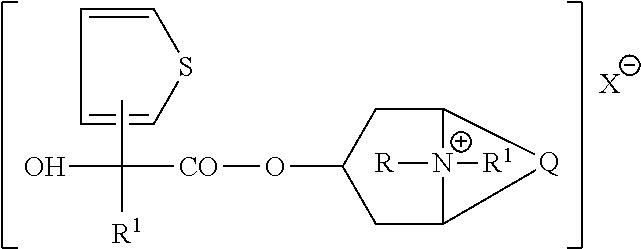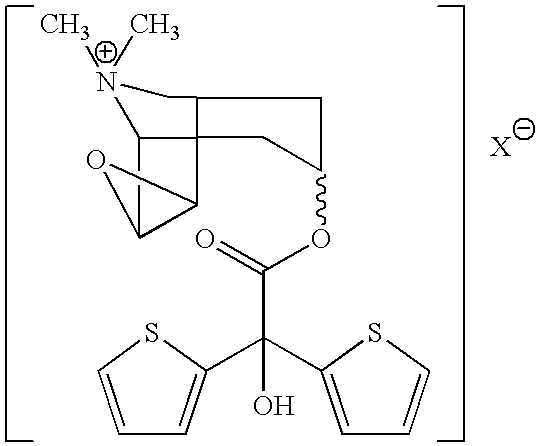Quaternary antimuscarinic compounds for the treatment of bladder diseases
a technology of muscarinic compounds and bladder diseases, applied in the field of methods of treating bladder diseases, can solve the problems of increasing the cost of treatment, limiting the acceptability of many patients, and unpleasant side effects, and achieve the effect of prolonging the duration of treatment and prolonging the maintenance of bladder control
- Summary
- Abstract
- Description
- Claims
- Application Information
AI Technical Summary
Benefits of technology
Problems solved by technology
Method used
Image
Examples
Embodiment Construction
[0034]The present invention relates to a method for treating bladder disease in a subject. This method involves administering to a subject a pharmaceutical composition having a therapeutic amount of a compound selected from the group consisting of: a compound having the formula
[0035]
where Q is a group of the formula
[0036]
R and R1 are each independently C1-C4-alkyl, R1 is thienyl, phenyl, cyclopentyl or cyclohexyl, and X− is a physiologically acceptable anion. In this aspect and all aspects of the present invention, R may be, without limitation, CH3, C2H5, n-C3H7, or i-C3H7; R1 may be, without limitation, CH3, and X− is meant to include, without limitation, bromide (Br−) and CH3SO3.
[0037]In another aspect of the present invention, treatment of a bladder disease involves administering to a subject a compound having the formula
[0038]
where X− is a physiologically acceptable ion as described herein above.
[0039]In another aspect of the present invention, treatment of a bladder disease inv...
PUM
| Property | Measurement | Unit |
|---|---|---|
| viscosity | aaaaa | aaaaa |
| concentrations | aaaaa | aaaaa |
| micturition frequency | aaaaa | aaaaa |
Abstract
Description
Claims
Application Information
 Login to View More
Login to View More - R&D
- Intellectual Property
- Life Sciences
- Materials
- Tech Scout
- Unparalleled Data Quality
- Higher Quality Content
- 60% Fewer Hallucinations
Browse by: Latest US Patents, China's latest patents, Technical Efficacy Thesaurus, Application Domain, Technology Topic, Popular Technical Reports.
© 2025 PatSnap. All rights reserved.Legal|Privacy policy|Modern Slavery Act Transparency Statement|Sitemap|About US| Contact US: help@patsnap.com



